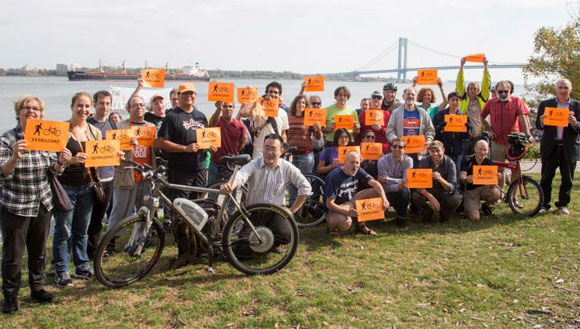
This Saturday, close to 100 people gathered at the Alice Austen House on the North Shore of Staten Island to demand a walking and biking path across the Verrazano Bridge. And in a sign of the campaign's growing political potency, several elected officials came out to announce their support for the idea, including Assembly Member Michael Cusick, State Senator Marty Golden, and City Council Member Vincent Gentile.
The bridge path now has the endorsement of nearly every local elected official on each side of the Verrazano. The main question left is whether Governor Cuomo will fix a 50-year-old mistake by Robert Moses and commit to providing walking and biking access between Staten Island and Brooklyn.
Two years ago, when advocates started mobilizing under the banner of the Harbor Ring Committee, such favorable politics were almost unthinkable. James Molinaro, the Staten Island borough president at the time, called the bridge path "absolutely ridiculous." Today it's the resistance to a walking and biking path that seems absurd.
The Harbor Ring Committee, which notes that the Verrazano project is the missing link in a 50-mile bikeable circuit around New York Harbor, has gathered more than 3,600 signatures in support of a path. Its advocacy has won over nearly every elected official whose turf touches the Verrazano.
Molinaro's successor, James Oddo, told the Times he supports a path if the costs are within reason and that the project "would provide an exciting new option for residents to combat our rising obesity epidemic or get to work." Oddo's counterpart in Brooklyn, Borough President Eric Adams, also supports the bridge path.
So do City Council members Vincent Ignizio and Debi Rose, Assembly Member Nicole Malliotakis, Assembly Member Joseph Borelli, the three electeds who came to Saturday's rally, and MTA board member Allen Cappelli, a Staten Island resident.
The Verrazano was intentionally built with enough space for walking and biking paths, which Moses then ruled out, purportedly to prevent suicides. In 1997, the firm that designed the bridge, Amman and Whitney, produced a report for the city that pegged the cost of the pathways, adjusted to 2012 dollars, at $50 million. The expense would be a rounding error in the MTA's upcoming five-year capital program.
The MTA has incorporated a feasibility study for the pathways into a larger project to reconstruct bridge ramps and approaches. The study is due in 2015, and at Saturday's rally, speakers urged the agency and its consultants, Parsons Brinckerhoff, to conduct the process transparently, so supporters of the path can weigh in before the results are set in stone.
"Fifty years without a Verrazano pathway has been 50 years too long," said Harbor Ring Committee member Paco Abraham. "Fortunately, now is the right time for change. The bridge is currently undergoing a massive rehab and we know with certainty that our ask is feasible and the demand is unwavering."





